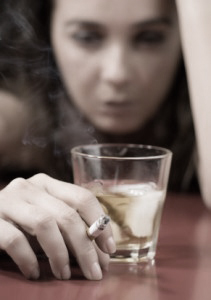 When it comes to alcohol and the negative effects it can have, it turns out that men and women are not equal after all. Research suggests that because of certain biological differences like size, body fat indexes, and hormonal systems, women get drunk quicker, with fewer drinks, and then are more prone to lasting negative health effects and social consequences.
When it comes to alcohol and the negative effects it can have, it turns out that men and women are not equal after all. Research suggests that because of certain biological differences like size, body fat indexes, and hormonal systems, women get drunk quicker, with fewer drinks, and then are more prone to lasting negative health effects and social consequences.
This biological difference between men and women in terms of the ability to tolerate alcohol is acknowledged in the fact that experts define high risk drinking differently for men (5 or more drinks in a sitting) and women (4 or more drinks in a sitting). The fact seems to be that women weigh less generally, have a greater ratio of fat to muscle, have less of a certain enzyme that is responsible for metabolizing alcohol, and have more estrogen which impedes the metabolism of alcohol, and these biological aspects of a women’s body make a big difference in terms of how she tolerates alcohol abuse and consumption.
Bottom-line, experts say, is that women and men respond differently to alcohol.
The Difference In Drinking Behaviors And Consequences Between Men And Women
In the past, men have been more likely to abuse alcohol, but now women are beginning to engage in dangerous drinking activities at rates near equal to men. So while surveys and research conducted at Purdue University in Indiana suggest alcohol abuse remains a bigger problem for men than for women—fewer female students (26.5 percent of those surveyed) said they had engaged in risky drinking behavior in the previous two weeks than did male students (30.3 percent)—these rates of abuse among the sexes also reflect tighter numbers than in the past. And while more men than women have alcohol abuse problems, researchers are beginning to find that women have more problems to do with alcohol—personal, social, and health related—than do men.
Data from this research shows that whereas 24.6 percent of women reported regretting an alcohol related or caused experience in the last 12 months, only 20 percent of men did so. Also, more women (35.8 percent) than men (31.3 percent) reported becoming nauseous while drinking in the previous 12 months, a fact that points towards women’s biological inability to tolerate excessive alcohol consumption. Finally, more women (1.6 percent) were sexually assaulted while using or abusing alcohol than were men (0.6 percent).
Women Can Make Good Choices To Protect Themselves From Alcohol Problems
Alcohol is one area where it seems that it might be in women’s best interest not to pursue or imagine equality. That is, because alcohol affects women more strongly and badly than it does men, women should not pretend like they can keep up drinking with men whether at the bar, at a party, or at home. Their bodies just won’t let them. Many women have found that knowing their limits when it comes to alcohol and being conscious of the negative impact alcohol can have is ultimately a smarter and more liberating choice. There are many smart decisions women, especially young women, can make in regards to alcohol. For example, women can make sure to eat a good meal before consuming alcohol. They can stick together in groups and make a pact to watch out for each other and help each other to make good decisions. Women can also avoid competitive drinking situations and drinking games with men where they are pushed to match men drink for drink. And this is an area where men can be helpful and not to egg women on to drink more than they can or want to. Ultimately, many women believe they are better able to seek equality in other areas when they acknowledge that there is no equality when it comes to the ability to tolerate alcohol.
It is always important to remember one rule when using this substance – be temperate. Don’t use alcohol in excess -this is the best way to avoid problems with the substance. For more information contact Narconon today.
Source: http://www.purdueexponent.org/opinion/columnists/article_1a6e120b-6045-5ac7-af8a-9772a6e98f37.html